Range Rover Evoque: Cylinder Block Components - 2.0L GTDi
Component Description
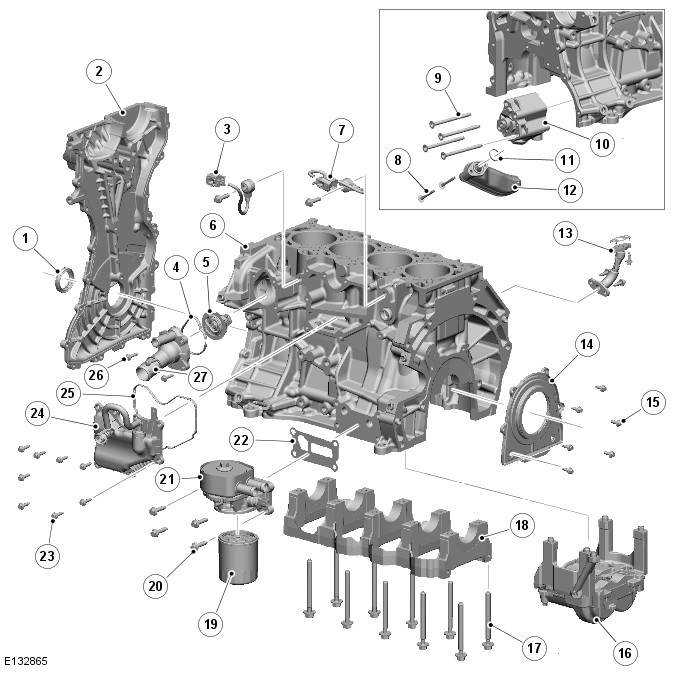
- Front crankshaft oil seal
- Front cover assembly
- Knock sensor - cylinders 1 and 2
- Gasket - thermostat housing
- Thermostat
- Cylinder block
- Knock sensor - cylinders 3 and 4
- Bolt (2 off)
- Bolt (3 off)
- Oil pump
- Gasket - oil pump inlet
- Oil pump filter and pick-up assembly
- Turbocharger oil return pipe
- Rear crankshaft oil seal and housing
- Screw (6 off)
- Balancer assembly
- Bolt (10 off)
- Engine bulkhead bearing support
- Oil filter
- Screw (4 off)
- Oil cooler and filter adaptor
- Gasket - Oil filter adaptor
- Screw (8 off)
- Crankcase ventilation cover
- Gasket - crankcase ventilation cover
- Screw (3 off)
- Thermostat housing
Cylinder Block
The cylinder block is an aluminum alloy casting with cast iron cylinder liners. Oil drain galleries run down the side of the block directing the returning oil away from the crankshaft, returning it to the fluid pan quickly. The galleries prevents the engine oil returning to the oil pan from falling onto the crankshaft, which produces drag.
Oil ways to each main bearing supply oil to lubricate the main bearings and also to supply, via a cross drilling, the connecting rod big end bearings.
The cylinders are numbered as shown below, with cylinder 1 at the front of the engine:
Engine Data Location
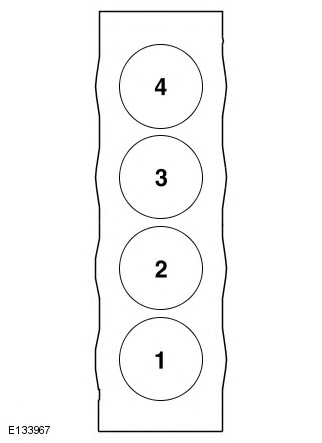
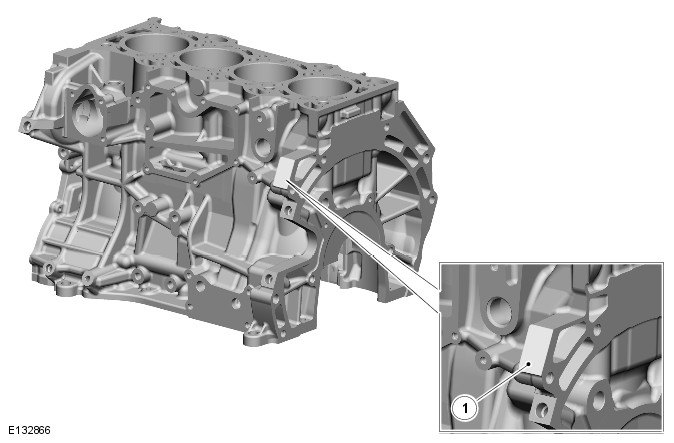
- Engine data location
Crankshaft
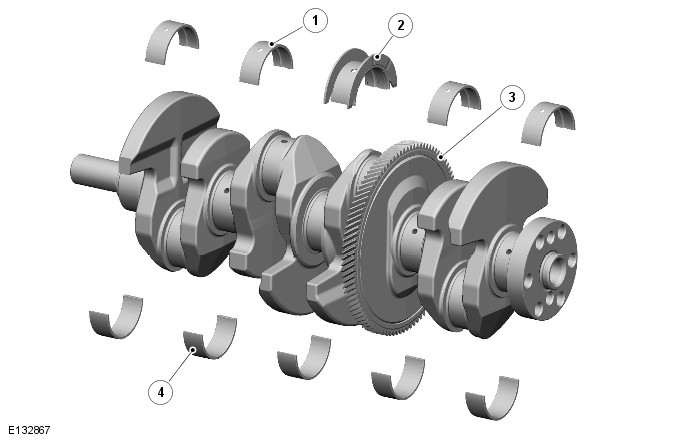
- Bearing shell - upper (4 off)
- Bearing shell - upper center thrust
- Balance shaft drive gear
- Bearing shell - lower (5 off)
The crankshaft is made from cast iron. Seven counter-balance weights ensure low vibration levels. An oil groove in the upper half of each main bearing transfers the oil into the crankshaft for lubrication of the main bearings. The upper center bearing shell has an integral thrust washer to counter end float.
The crankshaft is located high in the cylinder block and is retained in position by an aluminum alloy bulkhead bearing support which strengthens and braces the cylinder block.
Balance Shaft
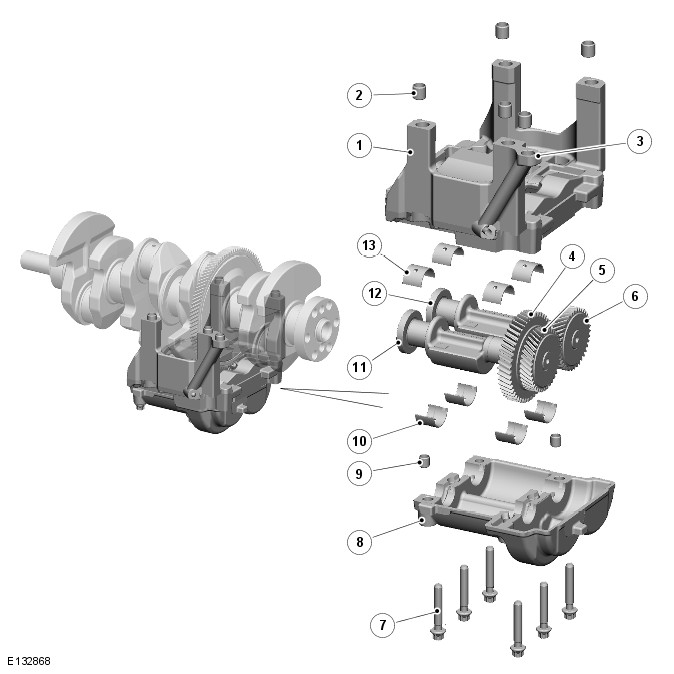
- Upper housing
- Location dowel (5 off)
- Oil supply gallery
- Intermediate gear - Driven balance shaft
- Driven gear - Driven balance shaft
- Idle gear - Idle balance shaft
- Bolt (6 off)
- Lower housing
- Dowel (2 off)
- Bearing shell - lower (4 off)
- Balance shaft - driven
- Balance shaft - idle
- Bearing shell - upper (4 off)
The balance shaft assembly comprises two eccentric weighted shafts which oppose vibrations created by the engine's rotating components. The balance shafts are driven off a 96 tooth ring gear located on the crankshaft which rotates a 48 tooth driven gear on the driven balance shaft.
The two balance shafts rotate in opposite directions, driven at twice the speed of the crankshaft. The equally sized eccentric weights are phased so that the inertia reaction to their counter-rotation cancels out vibration caused by the engine in both the horizontal and vertical planes.
Rotation of the driven gear is transferred by a second intermediate gear on the driven balance shaft to an idler gear on the idle balance shaft, which rotates at the same speed, but in the opposite direction.
The balance shafts are located on split shell bearings which are located in the upper and lower housings. An oil feed from the cylinder block supplies drillings in the lower housing to lubricate the shell bearings and the shafts.
The complete balance shaft assembly is attached to four bosses in the cylinder block by four bolts. Shims are positioned between the four bosses and the balance shaft assembly to obtain the correct meshing of the crankshaft ring gear and the balance shaft driven gear. The balance shaft must also be timed to crankshaft by positioning the crankshaft at TDC (top dead center) and aligning a mark on each balance shaft. Refer to Engine 303-01B for further details).
Piston and Connecting Rod
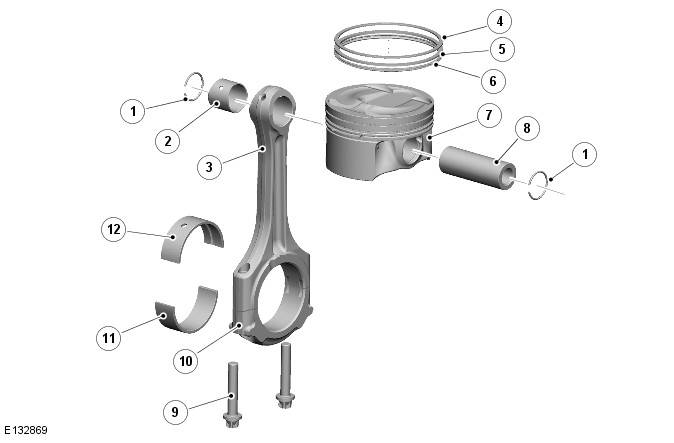
- Circlip (2 off)
- Bearing - connecting rod small end
- Connecting rod
- Piston ring - upper - compression
- Piston ring - lower - compression
- Oil control ring
- Piston
- Piston pin
- Bolt (2 off)
- Connecting rod - big end cap
- Bearing shell - lower - connecting rod big end
- Bearing shell - upper - connecting rod big end
The connecting rods are manufactured from forged powder metal and have fracture split big end caps to ensure precision re-assembly for bearing shell alignment.
There are a number of grades of large end bearing available, each being color coded. By measuring the crankshaft pin journal and the large end diameter of the connecting rod, the correct thickness large end bearing shells can be selected to give the optimum clearance.
A choice of three piston diameters are available. The diameter of each piston is measured and precisely matched to each cylinder bore diameter. Each piston has a grade number, 1, 2 or 3, which corresponds to its measured diameter.
The connecting rod and piston are marked to ensure correct assembly with the marks facing the front of the engine. The top face of piston has an arrow which must also point towards the front of the engine. Refer to Engine 303-01B for further details).
Piston
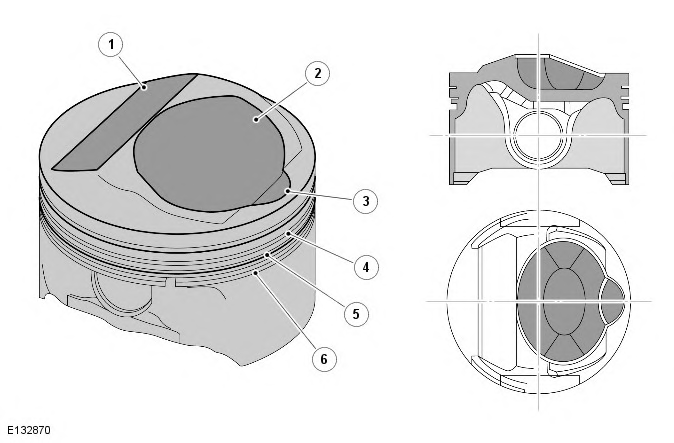
- Compression surface - exhaust side
- Piston recess
- Recess for high pressure injector
- Upper compression ring
- Lower compression ring
- Oil control ring
The piston crown has a recess for stabilisation of the fuel/air mixture. The recess is used together with the geometry of the intake path to optimise the transport of the intake air and the injected fuel to the spark plug.
The combustion chamber is enlarged by the piston recess. The piston has been finished in such a way that a compression surface is formed on the exhaust side of the piston crown. This compression surface is used to compensate for the material missing from the piston recess allowing the compression ratio to be achieved.
Piston Cooling Jets
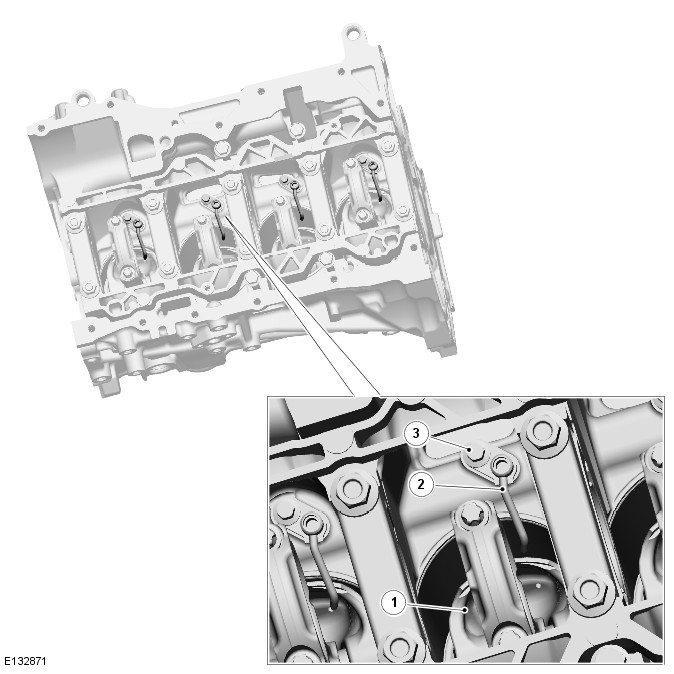
- Piston
- Piston cooling jet
- Bolt
Jets located in the cylinder block provide piston and piston pin lubrication and cooling. One jet per cylinder is used. Each jet is located in a drilling in the cylinder block and is secured with a bolt. Pressurized engine oil is supplied via the drilling to the jet from the oil pump.
The jets spray oil onto the inside of the piston. The oil coats the underside of the piston to help cool each piston crown.
Additionally the oil enters a hole in the top of the connecting rod and lubricates the small end bearing and piston pin.
Oil Filter and Cooler
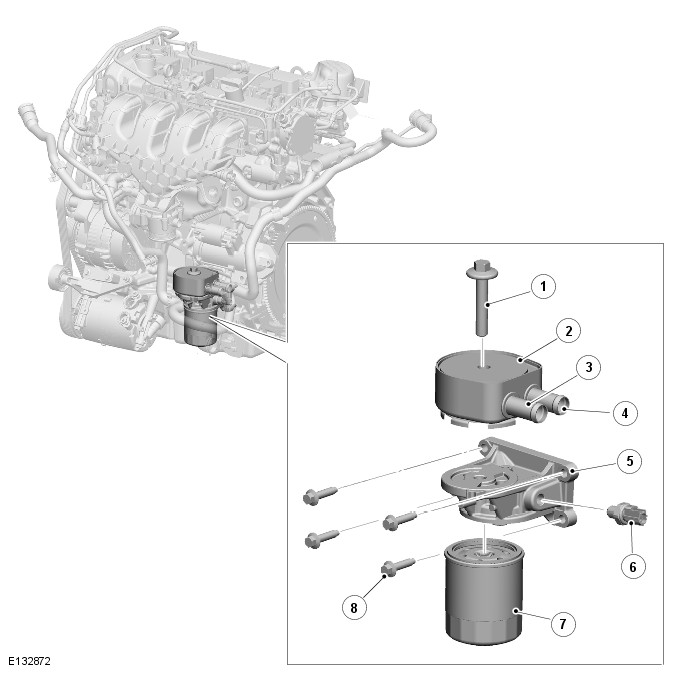
- Bolt
- Oil cooler assembly
- Engine coolant out - to thermostat housing
- Engine coolant in - from heater core
- Oil filter adaptor
- Oil pressure sensor
- Oil filter
- Bolt (4 off)
The engine oil cooler and filter assembly is located at the LH (left-hand) rear of the engine. The assembly comprises the oil filter element, a filter adaptor plate and the cooler.
The adaptor plate is attached to the cylinder block with four bolts and sealed with a gasket. The adaptor plate has a threaded port for location of the oil pressure sensor. The water cooler is located on the top of the adaptor plate and is sealed with a molded rubber gasket and secured with a bolt. The oil filter is a conventional cartridge type design with a threaded central port which screws onto a threaded boss on the adaptor plate.
Engine coolant returning from the heater core flows, via a hose, into the oil cooler and circulates around the body of the cooler before exiting via another hose to the thermostat housing. The engine coolant circulation draws heat from the cooler body which is generated by the hot engine oil.
Engine oil is directed from the cylinder block and into the adaptor plate. The oil circulates through galleries in the adaptor plate losing its heat via the plate body. The oil is then directed via the central threaded boss into the oil filter cartridge.
The oil flows through the filter elements and out of the filter cartridge via a number of holes to the adaptor plate and then back into the cylinder block.
Thermostat Housing
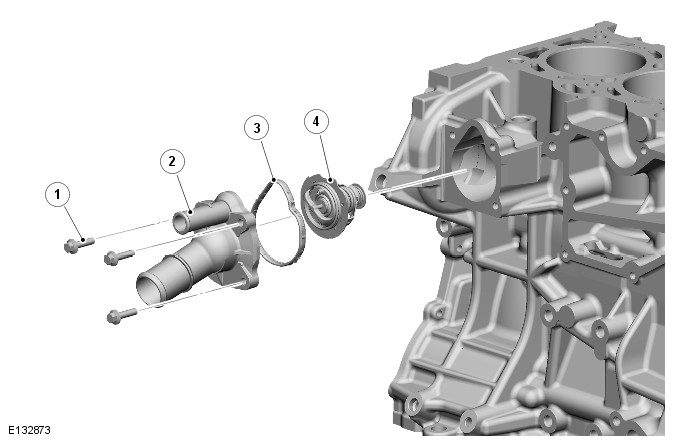
- Bolt (3 off)
- Housing
- Gasket
- Thermostat
The plastic thermostat housing is located on the front LH side of the cylinder block. The housing is secured to the cylinder block with three bolts and sealed with a gasket. The thermostat is contained within the housing The housing has two hose connections; the larger connection is for the bottom hose from the radiator, the smaller hose is the return from the oil cooler and coolant circulation from the degas tank.
Refer to: Engine Cooling (303-03B Engine Cooling - GTDi 2.0L Petrol, Description and Operation).
Front Pulley/Vibration Damper
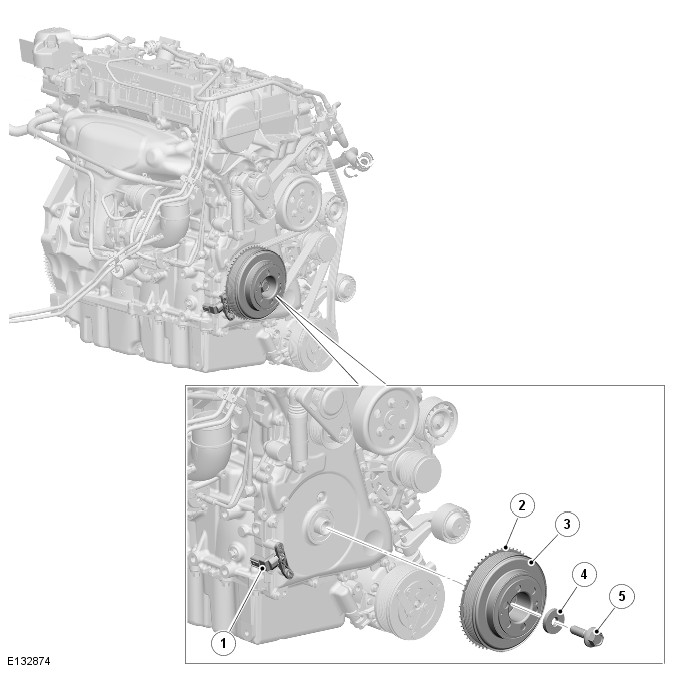
- Crankshaft Position (CKP) sensor
- Trigger wheel
- Pulley/vibration damper assembly
- Washer
- Bolt
The front crankshaft pulley is located on the end of the crankshaft and secured with a washer and bolt. The pulley drives the auxiliary drive belt for the ancillary components and incorporates a vibration damper and the trigger wheel for the CKP (crankshaft position) sensor.
NOTE: If the front pulley is removed, the engine must be set and held at TDC to maintain the engine timing.
The pulley incorporates an integral vibration damper which dampens vibration in the crankshaft produced by the combustion process. Each time a cylinder fires, torque is applied to the crankshaft via the pistons and connecting rods. The crankshaft deflects in reaction to the torque which creates a vibration when the torque is dissipated. The vibration damper absorbs the vibration reducing fatigue damage to the crankshaft.
The trigger wheel to the crankshaft position sensing is located on the rear of the pulley. The wheel has 58 teeth with a 2 teeth missing which in conjunction with the CKP enable the ECM to determine the rotational speed and position of the crankshaft. The position of the trigger wheel in relation to the crankshaft position is critical and special tools and procedures are required to obtain the correct correlation of the components.
Refer to: Crankshaft Pulley (303-01B Engine - GTDi 2.0L Petrol, Removal and Installation).
Crankshaft Position (CKP) Sensor
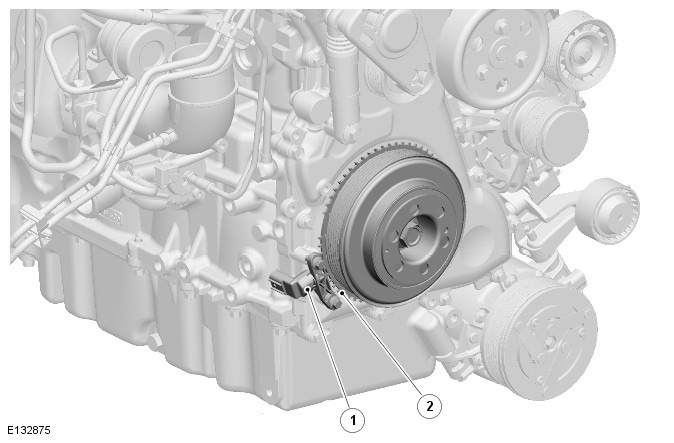
- Crankshaft Position (CKP) sensor
- Trigger wheel
The CKP sensor is located at the front of the engine, adjacent to the crankshaft pulley/vibration damper. The sensor is secured to two bosses on the engine front cover and secured with two bolts.
The CKP sensor is positioned adjacent to the trigger wheel, which is an integral part of the crankshaft pulley/vibration damper. The trigger wheel has 58 teeth and a section where 2 teeth are missing. The sensor is a Hall effect sensor which uses the missing teeth on the trigger wheel to determine the crankshaft position and rotational speed.
Special tools are required to obtain the correct alignment of the trigger wheel. The trigger wheel must be located in the correct orientation using a method described in the repair procedures.
Refer to: Crankshaft Pulley (303-01B Engine - GTDi 2.0L Petrol, Removal and Installation).
Water Pump
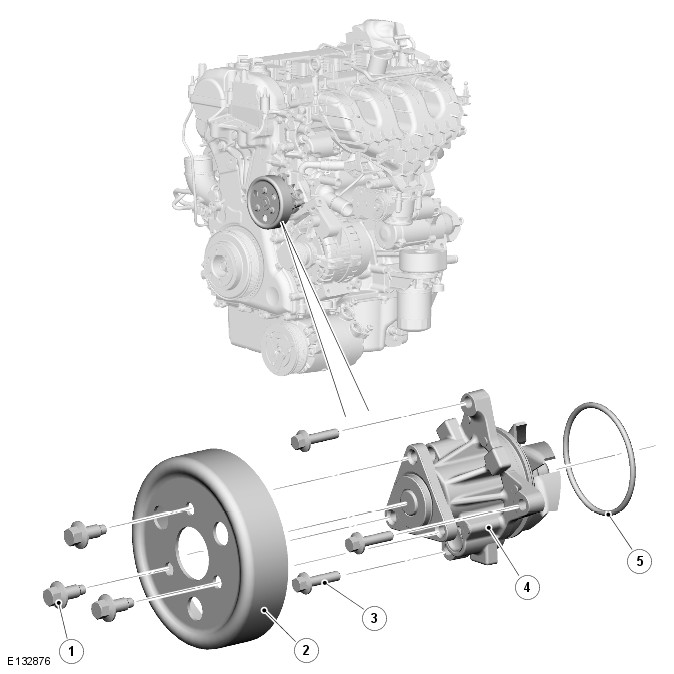
- Bolt (3 off)
- Pulley
- Bolt (3 off)
- Water pump assembly
- O ring seal
The water pump is located in a cavity in the cylinder block on the front upper LH side of the cylinder block. The pump is sealed in the block with an O ring seal and secured with three bolts.
A pulley which drives the pump at engine speed from the auxiliary drive belt is secured to the pump drive flange with three bolts.
Oil Pan
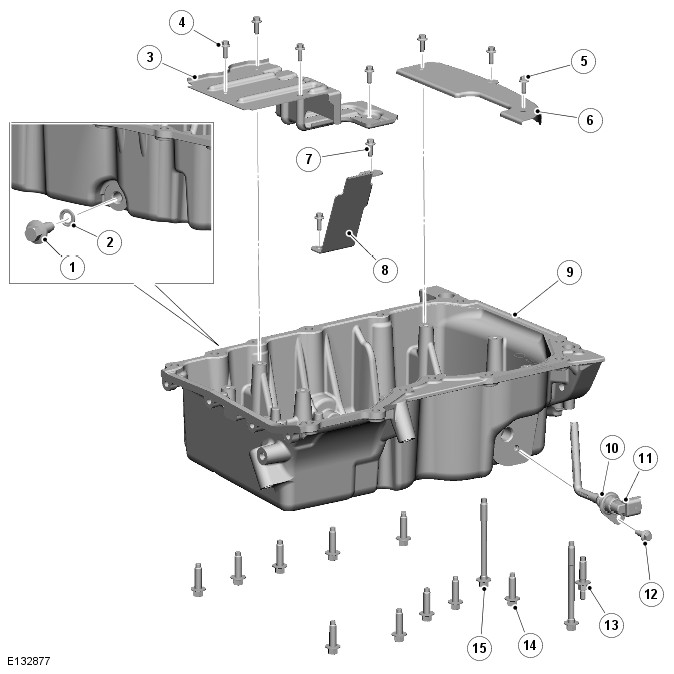
- Drain plug
- Sealing washer
- Baffle plate
- Bolt (4 off)
- Bolt (3 off)
- Baffle plate
- Bolt (2 off)
- Baffle
- Oil pan
- O ring seal (2 off)
- Engine oil temperature sensor
- Bolt
- Stud and nut - oil pan to cylinder block
- Bolt - oil pan to cylinder block (10 off)
- Bolt - oil pan to cylinder block (2 off)
The oil pan is located on the underside of the cylinder block. It is sealed to the cylinder block with a 3 mm bead of RTV sealant and secured with twelve bolts and one stud and nut.
The oil pan contains three baffle plates which are located inside the pan and secured with bolts. The baffles prevent oil surge when cornering, braking and acceleration.
The oil is drained via removal of a drain plug and washer located in one side of the oil pan.
An oil temperature sensor is located in one side of the oil pan. The sensor is sealed in a hole in the oil pan with two O ring seals and is secured with a bolt. The sensor is connected to the ECM.
Oil Level Gage
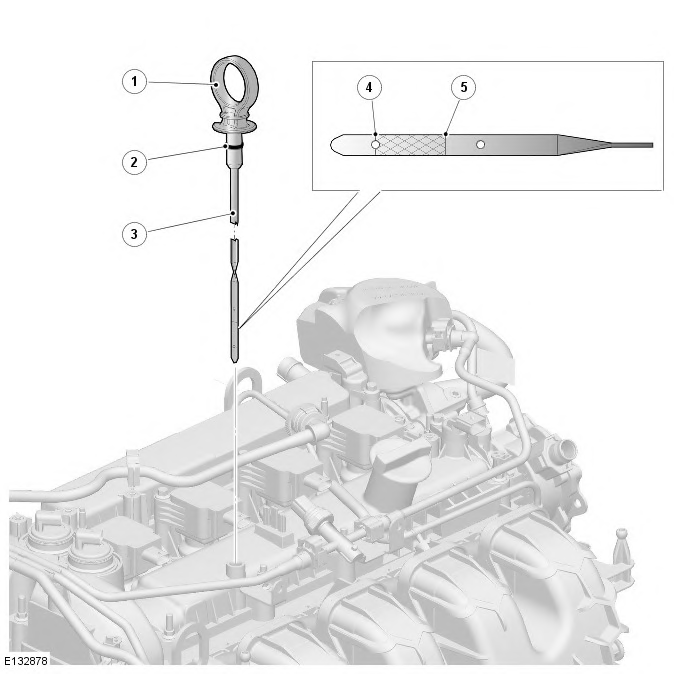
- Handle
- O ring seal
- Steel cable
- Minimum oil level
- Maximum oil level
Oil level is checked by the use of an oil level gage. The gage is located in a hole in the camshaft cover and is passed through the cylinder head and cylinder block into the fluid pan. The handle has a cut-out with locates in a boss on the camshaft cover. The handle is attached to a flexible steel cable which has the level gage attached to the bottom of it.
The bottom of the gage has two lines which are the minimum and maximum marks; the difference in oil quantity between the marks in 0.85 liter.
Oil Pump
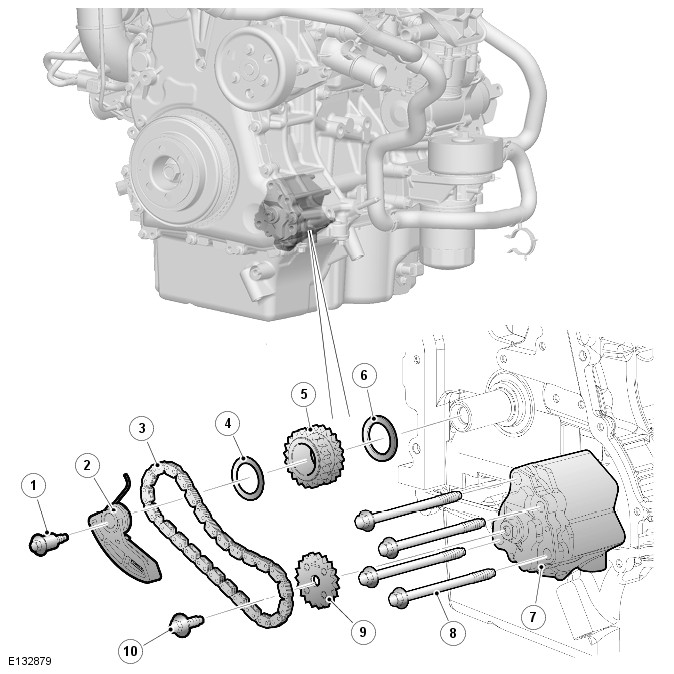
- Bolt - chain tensioner pivot
- Chain tensioner
- Oil pump drive chain
- Washer - crankshaft damper
- Camshaft and oil pump drive gear
- Washer - crankshaft damper
- Oil pump
- Bolt (4 off)
- Oil pump gear
- Bolt - oil pump gear
The oil pump is an eccentric rotor type pump and is attached to the cylinder block with four bolts. The input shaft of the oil pump is driven from the front of the crankshaft by a chain drive at crankshaft speed.
The oil pump draws oil from the oil pan through a filter and pick-up which is attached to the input port of the oil pump.
The oil is pressurized and pumped from the pump body into an oil gallery in the cylinder block. The oil is then direct through the oil cooler, filtered by the replaceable cartridge filter and distributed through oil galleries in the cylinder head and cylinder block. All moving parts are lubricated by pressure or splash oil. Pressurized oil is also provided for the cam and oil pump chains and tensioners and guides.
A pressure relief valve is located within the pump body and relieves excess oil pressure back into the pump body to be recirculated through the pump.

